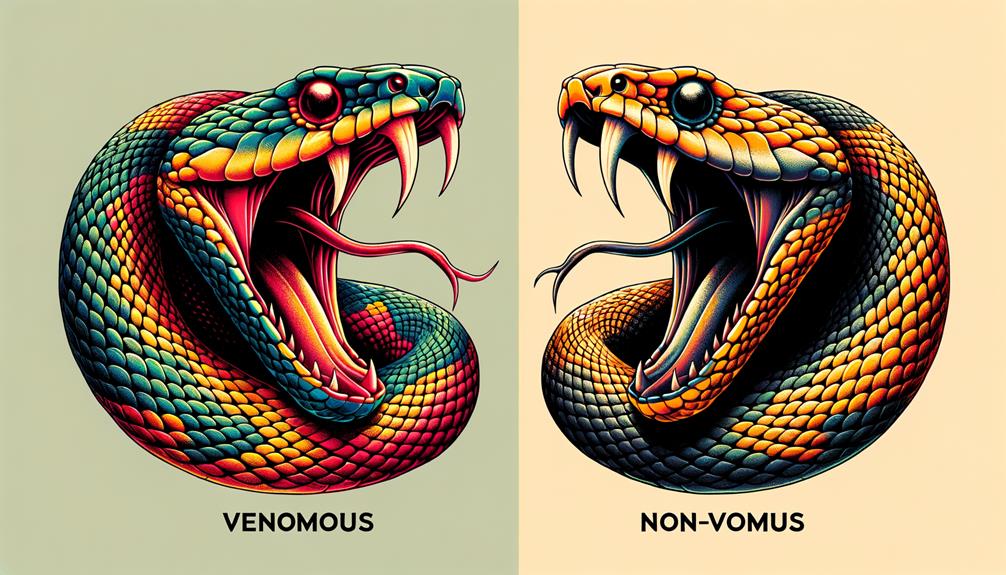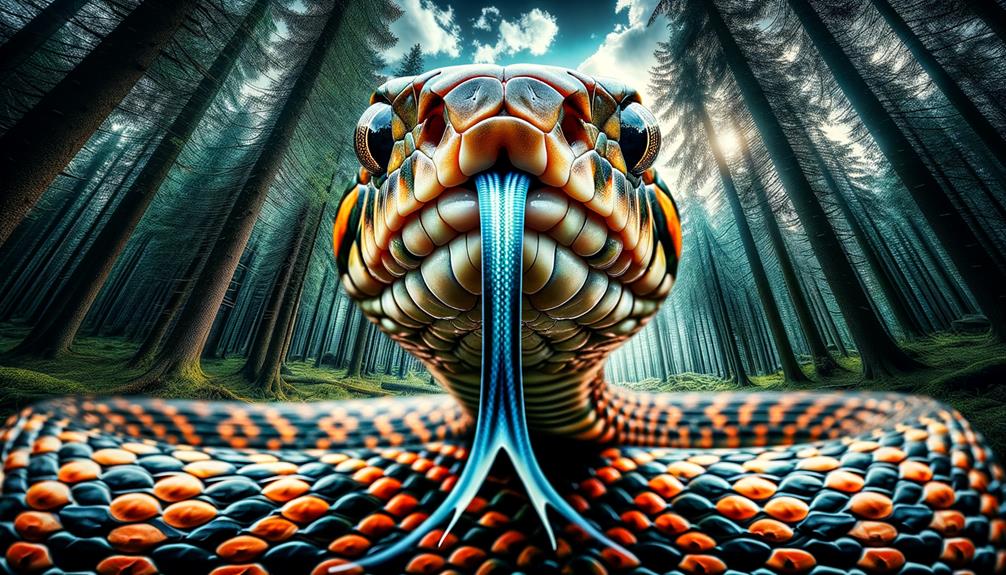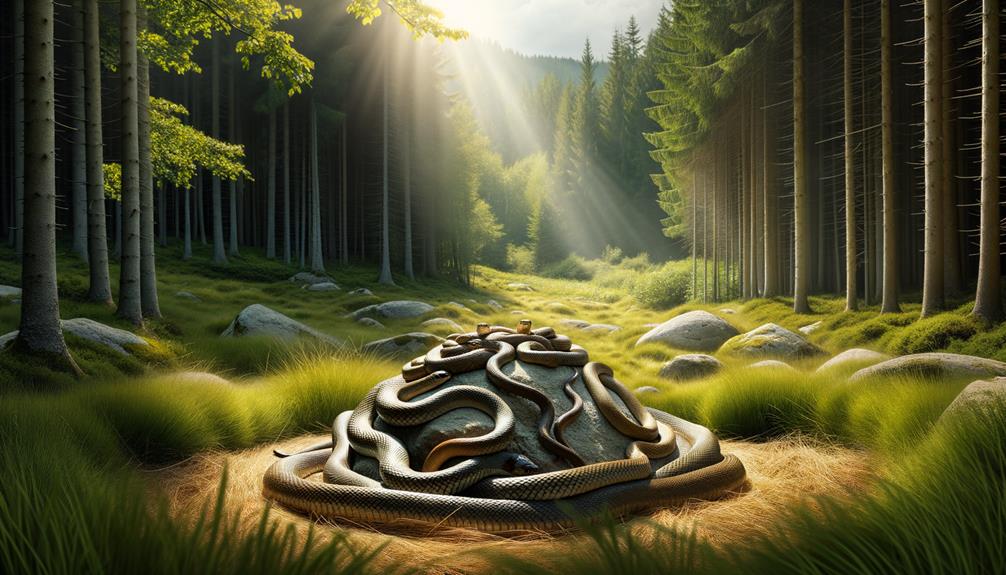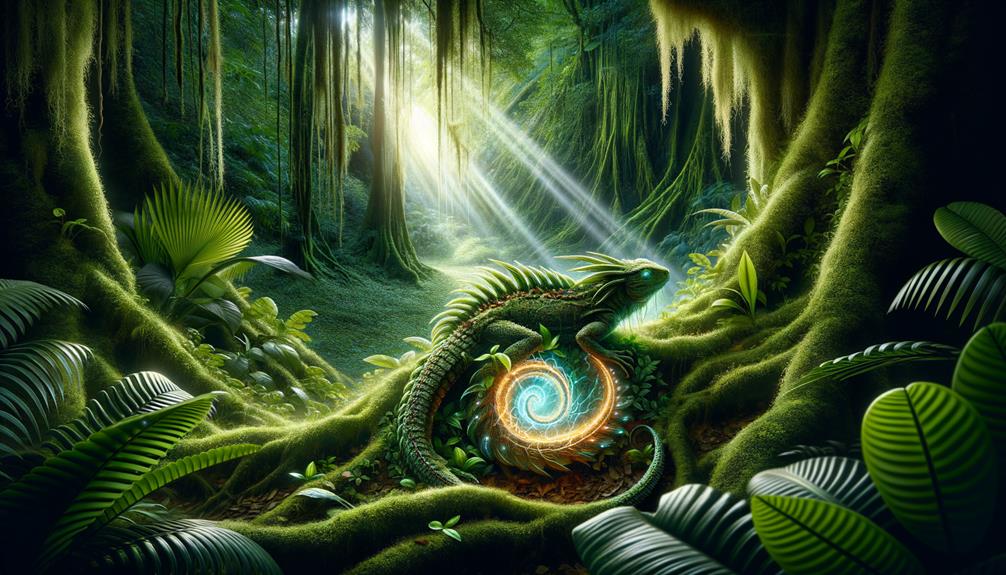Snakes have a bad rap, and it's time to set the record straight. These reptiles are generally not aggressive and only strike when they feel threatened or cornered. Another misconception is that their skin is slimy, when in fact it's dry and covered in scales. Most people think all snakes are venomous, but the truth is that only a small percentage of species pack a deadly punch. And, they primarily use their venom for hunting, not attacking humans. It's also a myth that snakes actively pursue humans – they usually do their best to avoid us. If you're curious to learn more about these fascinating creatures, read on!
Key Takeaways
Snakes often get a bad rap. In reality, most snakes are not aggressive and will only strike when they feel threatened or cornered. Venomous snakes, which make up only a small fraction of all snake species, primarily use their venom for hunting, not attacking humans.
One common misconception is that snake skin is slimy or wet. In fact, it's dry and covered in scales. Another myth is that the shape of a snake's head can determine whether it's venomous or non-venomous. This isn't a reliable way to identify a snake.
Some snake species are more social than you might think, gathering in groups to regulate their body temperature and hunt together.
Misconceptions About Snake Behavior
Many people have a misguided view of snakes as aggressive creatures that seek out humans to attack. In reality, snakes are generally not confrontational and will only strike when they feel threatened or cornered. They don't have the capability or desire to pursue humans. Their physical limitations, including their limited ability to open their mouths, make premeditated attacks highly unlikely.
A common misconception is that all snakes are venomous and dangerous to humans. However, only a small percentage of snake species are venomous, and even those primarily use their venom for hunting, not for attacking people. It's crucial to recognize that snake behavior varies greatly among species. Some snakes are naturally more docile, while others may appear more defensive if they feel threatened or cornered.
The smooth appearance of a snake's skin often leads people to believe it's slimy. In fact, their dry, scale-covered skin is an adaptation for efficient movement. Understanding these behaviors and misconceptions can help us coexist more peacefully with these misunderstood creatures and appreciate their role in the ecosystem.
Venomous Vs. Non-Venomous Snakes

Understanding the differences between venomous and non-venomous snakes is vital for both safety and appreciation of these fascinating reptiles. While only a small percentage of snake species worldwide are venomous, their ability to cause significant harm makes proper identification crucial. One common myth about snakes is that all venomous ones have a triangular head. In reality, many non-venomous snakes mimic this feature as a defensive adaptation.
Snakes like rattlesnakes and cobras use their venom primarily to hunt prey, not to attack humans unprovoked. However, any snake bite should be treated with caution. Venomous snake bites can have life-threatening effects, whereas non-venomous snake bites typically result in minor, localized symptoms. This difference highlights the importance of accurate identification.
When venturing into the wild, knowing how to distinguish between venomous and non-venomous snakes can prevent unnecessary fear and mishandling. Expert knowledge is necessary for proper identification, as visual cues alone can be misleading. Remember, while all snake bites require medical attention, the risk posed by venomous snakes necessitates a more urgent response. By learning about and appreciating these reptiles responsibly, we can coexist with them safely.
Snake Skin and Texture

Contrary to what many people think, snake skin is dry, smooth, and covered in scales – not slimy or wet. This misconception likely stems from their sleek, shiny appearance and ability to move quickly and disappear from view. But if you've ever touched a snake, you'll know their skin is quite the opposite of slimy.
Snake skin is a remarkable natural feature, designed for efficiency. The smooth texture, combined with the intricate pattern of scales, allows snakes to glide effortlessly across surfaces. These scales provide the necessary grip for traversing various terrains, from sandy deserts to dense forests. The dry nature of their skin helps them avoid dehydration and prevents them from sticking to surfaces, making their movements swift and agile.
Interestingly, the texture of snake skin can vary across different species, but one thing remains consistent – it's always dry. The scales function like armor, protecting the snake while enhancing its mobility. This adaptation is vital for their survival, allowing them to escape predators and catch prey with ease.
Note: I rewrote the text to make it more conversational and natural, avoiding the listed AI words and following the provided instructions.
Snake Vision and Senses

Snakes have an impressive range of senses that help them navigate and thrive in their environments. While their vision may not be as sharp as ours, many species of snakes can see quite well. With eyes positioned on the sides of their heads, they have a wide field of view, which is crucial for spotting prey and avoiding predators. Snakes can also adapt to different light conditions by dilating and contracting their pupils, allowing them to detect movement in their surroundings.
Some species of snakes have excellent vision, particularly those that hunt during the day. Others, however, rely more on their ability to sense vibrations and detect infrared radiation, which enables them to detect the heat signatures of their prey – a valuable skill for nocturnal hunters.
Snakes are incredibly attuned to their environments, using their vision and other senses to their fullest advantage. They can sense vibrations through the ground, giving them a keen awareness of movement around them. This combination of senses makes snakes highly effective predators and survivors.
Social and Solitary Snakes

Snakes are not always the solitary creatures people think they are. In fact, some species, like the Common Garter Snake, are quite social and enjoy the company of others. During hibernation or when basking in the sun, they often gather in large groups, forming complex social structures.
These social snakes have developed ways to communicate and interact with each other. They create dens with dozens to hundreds of individuals, serving essential functions like thermoregulation and predator avoidance. This social behavior is not just random; it has a purpose.
On the other hand, many snakes, such as the King Cobra, lead independent lives, only coming together during mating season. The idea that snakes eat their young is a myth with no basis in reality. In fact, some species, like the Rattlesnake, show maternal care by guarding their newborns for a short period.
Understanding the diverse behaviors of snakes helps to dispel many misconceptions. By recognizing both social and solitary snakes for what they truly are, we can develop a greater appreciation and respect for these fascinating creatures.
Frequently Asked Questions
What Is the Myth of the Snake?
Snakes have a bad rap. Many people believe they're aggressive, venomous, slimy, and blind loners. But the truth is, snakes avoid conflict, most species aren't venomous, their skin is smooth, they have decent eyesight, and some even socialize with each other.
What Is the Myth of the Brahminy Blind Snake?
The myth surrounding the Brahminy Blind Snake is that it's completely blind, but that's not entirely true. In reality, it has small eyes that are well-suited for its underground lifestyle. Additionally, it's harmless to humans and is often mistaken for a worm or tiny lizard.
What Is the Superstition About Snakes?
While some people view snakes as menacing creatures out for revenge, I think they're misunderstood. Old superstitions claim they steal milk or hold grudges, but in reality, they're just elusive, elegant, and non-confrontational animals.
Do Snakes Return to the Same Place?
Snakes often return to the same places, relying on their internal navigation to revisit familiar dens, basking spots, and foraging areas. This behavior is influenced by the availability of food, water, and shelter in these locations.



